Toro 71242, 71243, 71245 Operator's Manual
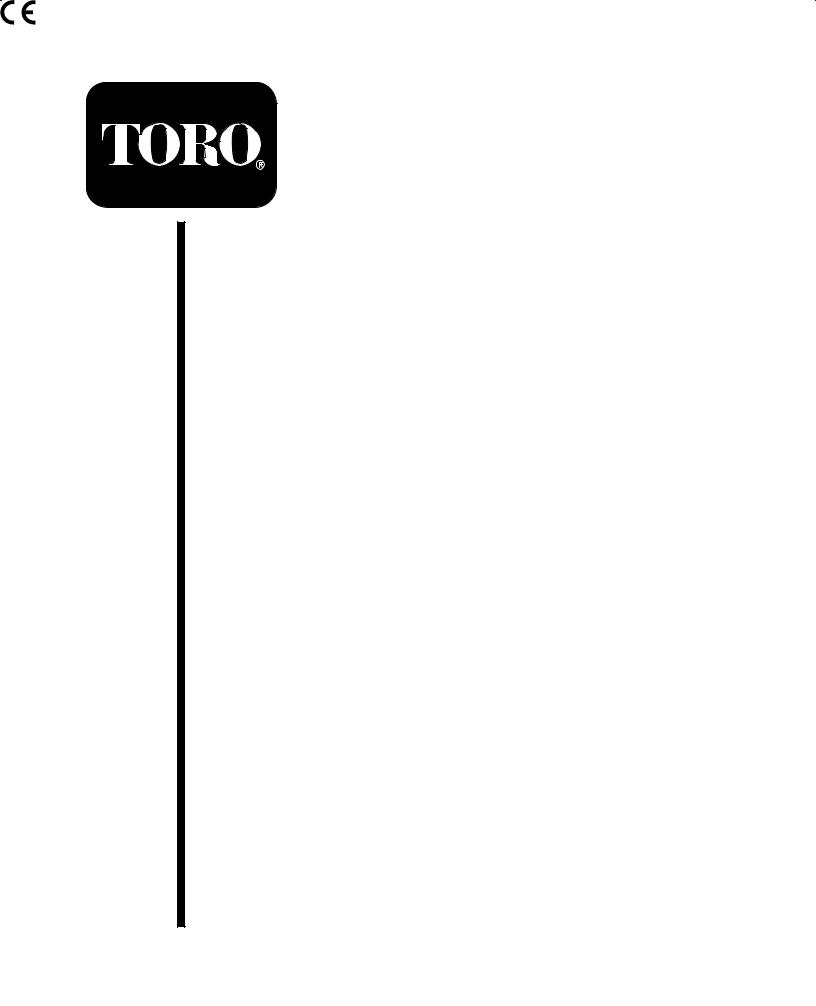
Form No. 3329-996
14-38HXLE, 16-38HXLE, and
17-38HXLE
Wheel Horse Lawn Tractors
Model No. 71242ÐSerial No. 240000001 and Up
Model No. 71243ÐSerial No. 240000001 and Up
Model No. 71245ÐSerial No. 240000001 and Up
Operator's Manual
Original Instructions (GB)
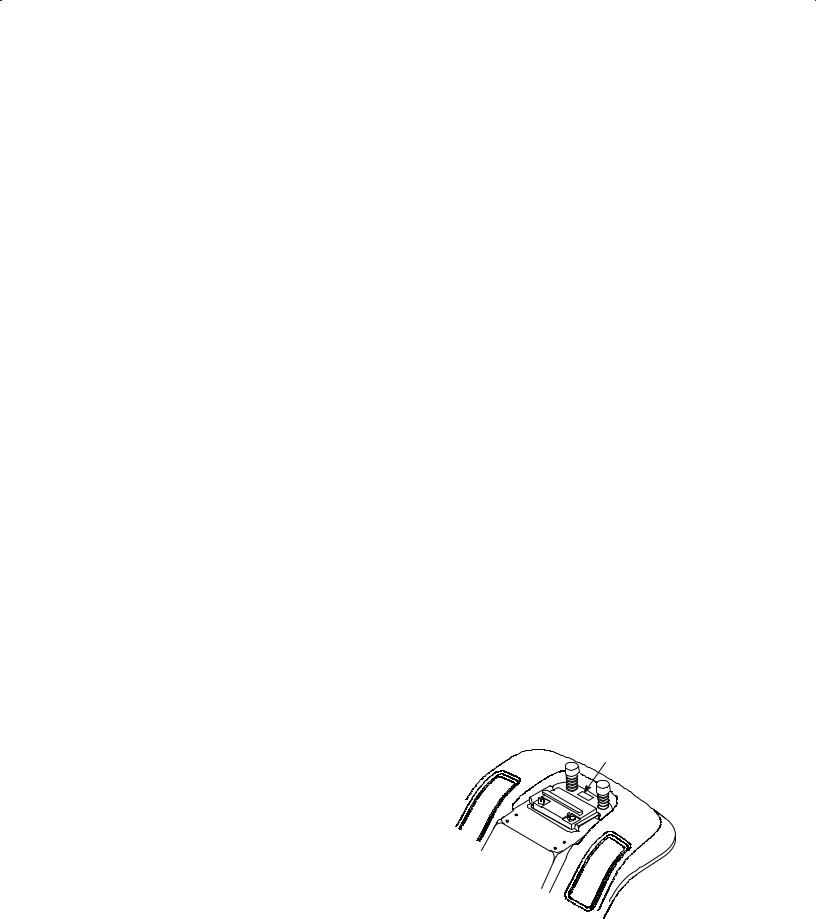
This spark ignition system complies with Canadian |
|
ICES-002. |
|
Ce système d'allumage par étincelle de véhicule est |
|
conforme à la norme NMB-002 du Canada. |
|
Contents |
|
|
Page |
Introduction . . . . . . . . . . . . . . . . . . . . . . . . . . . . . . . . |
2 |
Safety . . . . . . . . . . . . . . . . . . . . . . . . . . . . . . . . . . . . . |
3 |
Safe Operation Practices for Ride-on (Riding) |
|
Rotary Lawn Mowers . . . . . . . . . . . . . . . . . . . . |
3 |
Toro Riding Mower Safety . . . . . . . . . . . . . . . . . . |
5 |
Sound Pressure . . . . . . . . . . . . . . . . . . . . . . . . . . . |
5 |
Sound Power . . . . . . . . . . . . . . . . . . . . . . . . . . . . |
5 |
Vibration . . . . . . . . . . . . . . . . . . . . . . . . . . . . . . . . |
5 |
Slope Chart . . . . . . . . . . . . . . . . . . . . . . . . . . . . . . |
7 |
Safety and Instruction Decals . . . . . . . . . . . . . . . . |
9 |
Gasoline and Oil . . . . . . . . . . . . . . . . . . . . . . . . . . . . . |
12 |
Recommended Gasoline . . . . . . . . . . . . . . . . . . . . |
12 |
Using Stabilizer/Conditioner . . . . . . . . . . . . . . . . |
12 |
Filling the Fuel Tank . . . . . . . . . . . . . . . . . . . . . . |
12 |
Checking the Engine Oil Level . . . . . . . . . . . . . . |
12 |
Operation . . . . . . . . . . . . . . . . . . . . . . . . . . . . . . . . . . |
13 |
Controls . . . . . . . . . . . . . . . . . . . . . . . . . . . . . . . . |
13 |
Using the Parking Brake . . . . . . . . . . . . . . . . . . . . |
13 |
Positioning the Seat . . . . . . . . . . . . . . . . . . . . . . . |
13 |
Using the Headlights . . . . . . . . . . . . . . . . . . . . . . |
14 |
Using the Blade Control (PTO) . . . . . . . . . . . . . . |
14 |
Setting the Height of Cut . . . . . . . . . . . . . . . . . . . |
14 |
Adjusting the Mower Wheels . . . . . . . . . . . . . . . . |
14 |
Starting the Engine . . . . . . . . . . . . . . . . . . . . . . . . |
14 |
Stopping the Engine . . . . . . . . . . . . . . . . . . . . . . . |
15 |
Using the Safety Interlock System . . . . . . . . . . . . |
15 |
Testing the Safety Interlock System . . . . . . . . . . . |
16 |
Pushing the Tractor Manually . . . . . . . . . . . . . . . |
17 |
Driving Forward or Backward . . . . . . . . . . . . . . . |
17 |
Stopping the Tractor . . . . . . . . . . . . . . . . . . . . . . . |
17 |
Side Discharge or Mulch Grass . . . . . . . . . . . . . . |
18 |
Installing the Discharge Cover . . . . . . . . . . . . . . . |
18 |
Operating Tips . . . . . . . . . . . . . . . . . . . . . . . . . . . |
19 |
Maintenance . . . . . . . . . . . . . . . . . . . . . . . . . . . . . . . . |
20 |
Recommended Maintenance Schedule . . . . . . . . . |
20 |
Servicing the Engine Oil . . . . . . . . . . . . . . . . . . . |
21 |
Servicing the Battery . . . . . . . . . . . . . . . . . . . . . . |
22 |
Servicing the Parking Brake . . . . . . . . . . . . . . . . . |
24 |
Greasing and Lubricating the Tractor . . . . . . . . . . |
25 |
|
Page |
Servicing the Air Cleaner . . . . . . . . . . . . . . . . . . . |
25 |
Servicing the Spark Plug . . . . . . . . . . . . . . . . . . . |
26 |
Cleaning the Cooling System . . . . . . . . . . . . . . . . |
27 |
Checking the Tire Pressure . . . . . . . . . . . . . . . . . . |
27 |
Draining the Fuel Tank . . . . . . . . . . . . . . . . . . . . . |
27 |
Replacing the Fuel Filter . . . . . . . . . . . . . . . . . . . |
27 |
Servicing the Transaxle Fluid . . . . . . . . . . . . . . . . |
28 |
Servicing the Fuse . . . . . . . . . . . . . . . . . . . . . . . . |
28 |
Servicing the Headlights . . . . . . . . . . . . . . . . . . . . |
28 |
Servicing the Blades . . . . . . . . . . . . . . . . . . . . . . . |
29 |
Removing the Mower . . . . . . . . . . . . . . . . . . . . . . |
30 |
Installing the Mower . . . . . . . . . . . . . . . . . . . . . . |
32 |
Replacing the Blade Drive Belt . . . . . . . . . . . . . . |
33 |
Leveling the Mower from Side-to-Side . . . . . . . . |
34 |
Adjusting the Front-to-Rear Blade Slope . . . . . . . |
34 |
Washing the Underside of the Mower . . . . . . . . . |
35 |
Cleaning and Storage . . . . . . . . . . . . . . . . . . . . . . |
36 |
Wiring Diagram . . . . . . . . . . . . . . . . . . . . . . . . . . |
38 |
Troubleshooting . . . . . . . . . . . . . . . . . . . . . . . . . . . . . |
39 |
Introduction
Read this manual carefully to learn how to operate and maintain your product properly. The information in this manual can help you and others avoid injury and product damage. Although Toro designs and produces safe products, you are responsible for operating the product properly and safely.
You may contact Toro directly at www.Toro.com for product and accessory information, help finding a dealer, or to register your product.
Whenever you need service, genuine Toro parts, or additional information, contact an Authorized Service Dealer or Toro Customer Service and have the model and serial numbers of your product ready. Figure 1 illustrates the location of the model and serial numbers on the product.
1
m-1856
Figure 1
1. Location of the model and serial numbers
2003 by The Toro Company |
|
Contact us at www.Toro.com |
8111 Lyndale Avenue South |
|
All Rights Reserved |
Bloomington, MN 55420-1196 |
2 |
Printed in the USA |

Write the product model and serial numbers in the space below:
Model No.
Serial No.
This manual identifies potential hazards and has special safety messages that help you and others avoid personal injury and even death. Danger, Warning, and Caution are signal words used to identify the level of hazard. However, regardless of the hazard, be extremely careful.
Danger signals an extreme hazard that will cause serious injury or death if you do not follow the recommended precautions.
Warning signals a hazard that may cause serious injury or death if you do not follow the recommended precautions.
Caution signals a hazard that may cause minor or moderate injury if you do not follow the recommended precautions.
This manual uses 2 other words to highlight information. Important calls attention to special mechanical
information and Note: emphasizes general information worthy of special attention.
•Never mow while people, especially children, or pets are nearby.
•Keep in mind that the operator or user is responsible for accidents or hazards occurring to other people or their property.
•Do not carry passengers.
•All drivers should seek and obtain professional and practical instruction. Such instruction should emphasize:
±the need for care and concentration when working with ride-on machines;
±control of a ride-on machine sliding on a slope will not be regained by the application of the brake. The main reasons for loss of control are:
•insufficient wheel grip;
•being driven too fast;
•inadequate braking;
•the type of machine is unsuitable for its task;
•lack of awareness of the effect of ground conditions, especially slopes;
•incorrect hitching and load distribution.
Safety
Safe Operation Practices for Ride-on (Riding) Rotary Lawn Mowers
Read and understand the contents of this manual before operating the tractor.
 This is the safety alert symbol. It is used to alert you to potential personal injury hazards. Obey all safety messages that follow this symbol to avoid possible injury or death.
This is the safety alert symbol. It is used to alert you to potential personal injury hazards. Obey all safety messages that follow this symbol to avoid possible injury or death.
The following instructions are from the CEN standard EN 836:1997.
This product is capable of amputating hands and feet and of throwing objects. Always follow all safety instructions to avoid serious injury or death.
Training
•Read the instructions carefully. Be familiar with the controls and the proper use of the equipment.
•Never allow children or people unfamiliar with these instructions to use the lawnmower. Local regulations can restrict the age of the operator.
Preparation
•While mowing, always wear substantial footwear and long trousers. Do not operate the equipment when barefoot or wearing open sandals.
•Thoroughly inspect the area where the equipment is to be used and remove all objects which may be thrown by the machine.
•WarningÐFuel is highly flammable.
±Store fuel in containers specifically designed for this purpose.
±Refuel outdoors only and do not smoke while refuelling.
±Add fuel before starting the engine. Never remove the cap of the fuel tank or add fuel while the engine is running or when the engine is hot.
±If fuel is spilled, do not attempt to start the engine but move the machine away from the area of spillage and avoid creating any source of ignition until fuel vapors have dissipated.
±Replace all fuel tanks and container caps securely.
•Replace faulty silencers.
•Before using, always visually inspect to see that the blades, blade bolts and cutter assembly are not worn or damaged. Replace worn or damaged blades and bolts in sets to preserve balance.
3

•On multi-bladed machines, take care as rotating one blade can cause other blades to rotate.
Operation
•Do not operate the engine in a confined space where dangerous carbon monoxide fumes can collect.
•Mow only in daylight or in good artificial light.
•Before attempting to start the engine, disengage all blade attachment clutches and shift into neutral.
•Do not use on slopes of more than
±5 when mowing on side hills;
±10 when mowing uphill;
±15 when mowing downhill.
•Remember there is no such thing as a safe slope. Travel on grass slopes requires particular care. To guard against overturning:
±do not stop or start suddenly when going up or downhill;
±engage clutch slowly, always keep machine in gear, especially when travelling downhill;
±machine speeds should be kept low on slopes and during tight turns;
±stay alert for humps and hollows and other hidden hazards;
±never mow across the face of the slope, unless the lawnmower is designed for this purpose.
•Use care when pulling loads or using heavy equipment.
±Use only approved drawbar hitch points.
±Limit loads to those you can safely control.
±Do not turn sharply. Use care when reversing.
±Use counterweight(s) or wheel weights when suggested in the instruction handbook.
•Watch out for traffic when crossing or near roadways.
•Stop the blades rotating before crossing surfaces other than grass.
•When using any attachments, never direct discharge of material toward bystanders nor allow anyone near the machine while in operation.
•Never operate the machine with damaged guards or without safety protective devices in place.
•Do not change the engine governor settings or overspeed the engine. Operating the engine at excessive speed can increase the hazard of personal injury.
•Before leaving the operator's position:
±disengage the power take-off and lower the attachments;
±change into neutral and set the parking brake;
±stop the engine and remove the key.
•Disengage drive to attachments, stop the engine, and disconnect the spark plug wire(s) or remove the ignition key
±before clearing blockages or unclogging chute;
±before checking, cleaning or working on the lawnmower;
±after striking a foreign object. Inspect the lawnmower for damage and make repairs before restarting and operating the equipment;
±if the machine starts to vibrate abnormally (check immediately).
•Disengage drive to attachments when transporting or not in use.
•Stop the engine and disengage drive to attachment
±before refuelling;
±before removing the grass catcher;
±before making height adjustment unless adjustment can be made from the operator's position.
•Reduce the throttle setting during engine run-out and, if the engine is provided with a shut-off valve, turn the fuel off at the conclusion of mowing.
Maintenance and Storage
•Keep all nuts, bolts and screws tight to be sure the equipment is in safe working condition.
•Never store the equipment with fuel in the tank inside a building where fumes can reach an open flame or spark.
•Allow the engine to cool before storing in any enclosure.
•To reduce the fire hazard, keep the engine, silencer, battery compartment and fuel storage area free of grass, leaves, or excessive grease.
•Check the grass catcher frequently for wear or deterioration.
•Replace worn or damaged parts for safety.
•If the fuel tank has to be drained, this should be done outdoors.
•On multi-bladed machines, take care as rotating one blade can cause other blades to rotate.
•When machine is to be parked, stored or left unattended, lower the cutting means unless a positive mechanical lock is used.
4

Toro Riding Mower Safety
The following paragraph contains safety information specific to Toro products that is not included in the CEN standard.
Use only Toro-approved attachments. The warranty may be voided if you use the tractor with unapproved attachments.
Sound Pressure
This unit has a maximum sound pressure level at the operator's ear of 88 dBA, based on measurements of identical machines per Directive 98/37/EC.
Sound Power
This unit has a guaranteed sound power level of 100 dBA, based on measurements of identical machines per Directive 2000/14/EC.
Vibration
This unit does not exceed a hand/arm vibration level of 4.0 m/s2, based on measurements of identical machines per Directive 98/37/EC.
This unit does not exceed a whole body vibration level of 0.2 m/s2, based on measurements of identical machines per Directive 98/37/EC.
5

6
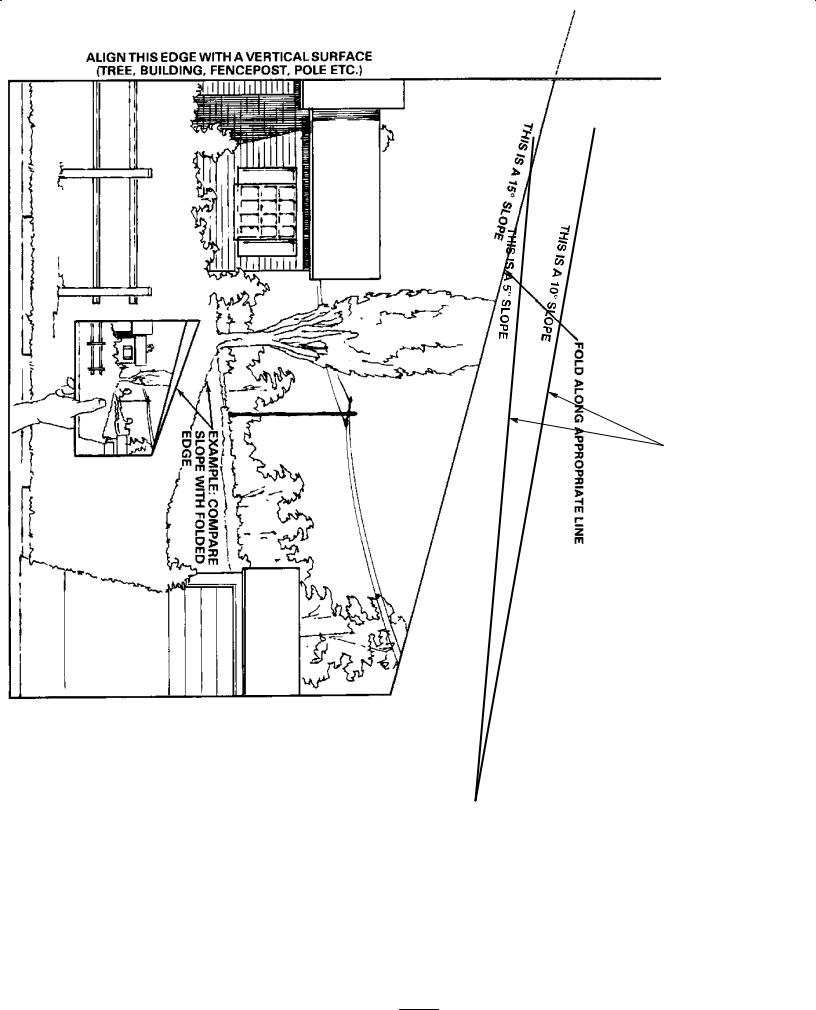
Slope Chart
7

8
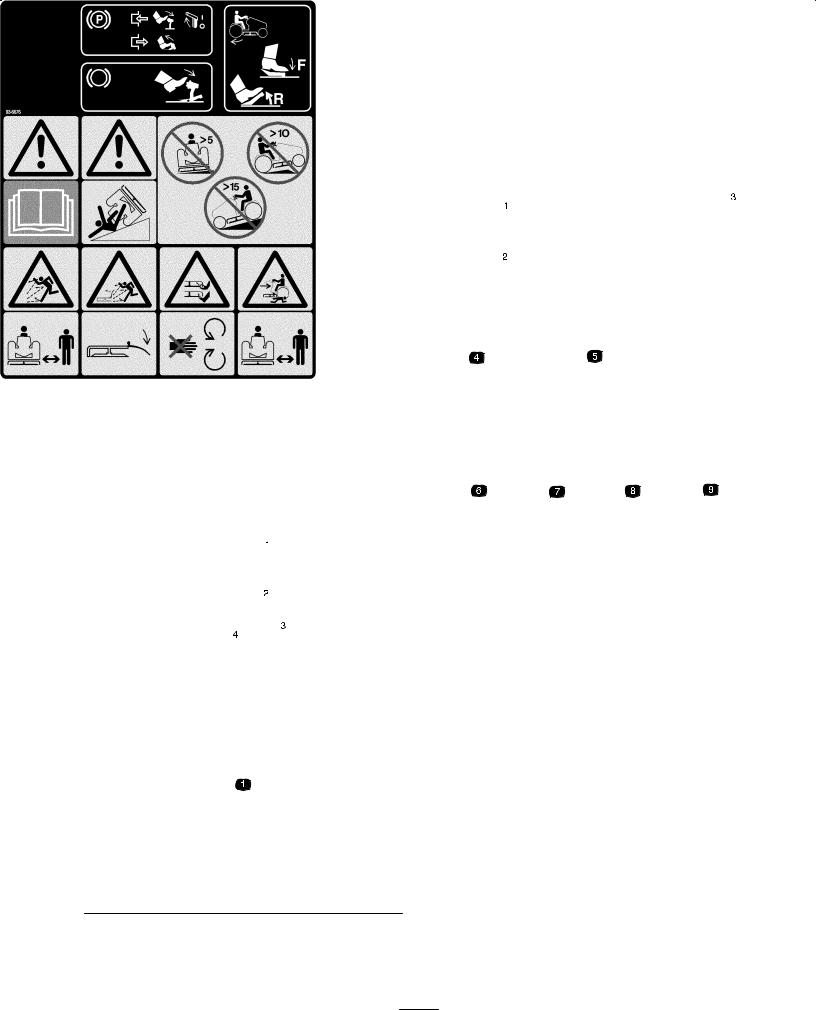
Safety and Instruction Decals
Safety decals and instructions are easily visible to the operator and are located near any area of potential danger. Replace any decal that is damaged or lost.
92-5730
1. |
Choke |
3. |
Continuous variable |
|
2. |
Fast |
|
setting |
|
4. |
Slow |
|||
|
|
|||
|
|
|
|
|
|
|
|
|
|
93-6676 |
|
|
|
1. |
Parking brakeÐto engage, press the brake pedal and lift the |
||
|
|
|
|
|
|
parking brake lever; to disengage press and release the brake |
|
|
|
|
|
|
pedal. |
|
|
|
2. |
BrakeÐto engage, press the brake pedal. |
||
|
|
|
3. |
Traction driveÐto drive forward, press the top of the traction |
||
|
|
|
|
|
|
control pedal forward and down; to drive in reverse, press the |
|
|
|
|
|
|
bottom of the traction control pedal rearward and down. |
|
|
93-6673 |
4. |
WarningÐread the Operator's Manual. |
||
|
|
5. |
WarningÐto avoid tipping the tractor, do not drive across |
|||
|
|
|
||||
1. |
Engage |
3. |
Disengage |
slopes greater than 5 degrees, up slopes greater than 10 |
||
2. |
Power take-off (PTO) |
4. |
Parking brake |
degrees, or down slopes greater than 15 degrees. |
||
|
||||||
|
|
|
6. |
Thrown object hazardÐkeep bystanders a safe distance from |
||
|
|
|
|
|
|
the machine. |
|
|
|
|
|
|
|
|
|
|
7. |
Thrown object hazard, mowerÐkeep the deflector in place. |
||
|
|
|
8. |
Cutting/dismemberment hazard of hand or foot, mower |
||
|
|
|
|
|
|
bladeÐstay away from moving parts. |
|
|
|
9. |
Crushing/dismemberment of a bystanderÐkeep bystanders a |
||
|
|
|
|
|
|
safe distance from the machine. |
|
|
|
|
|
|
|
93-6674
1.Crushing hazard, handÐread the instructions before servicing or performing maintenance.
9
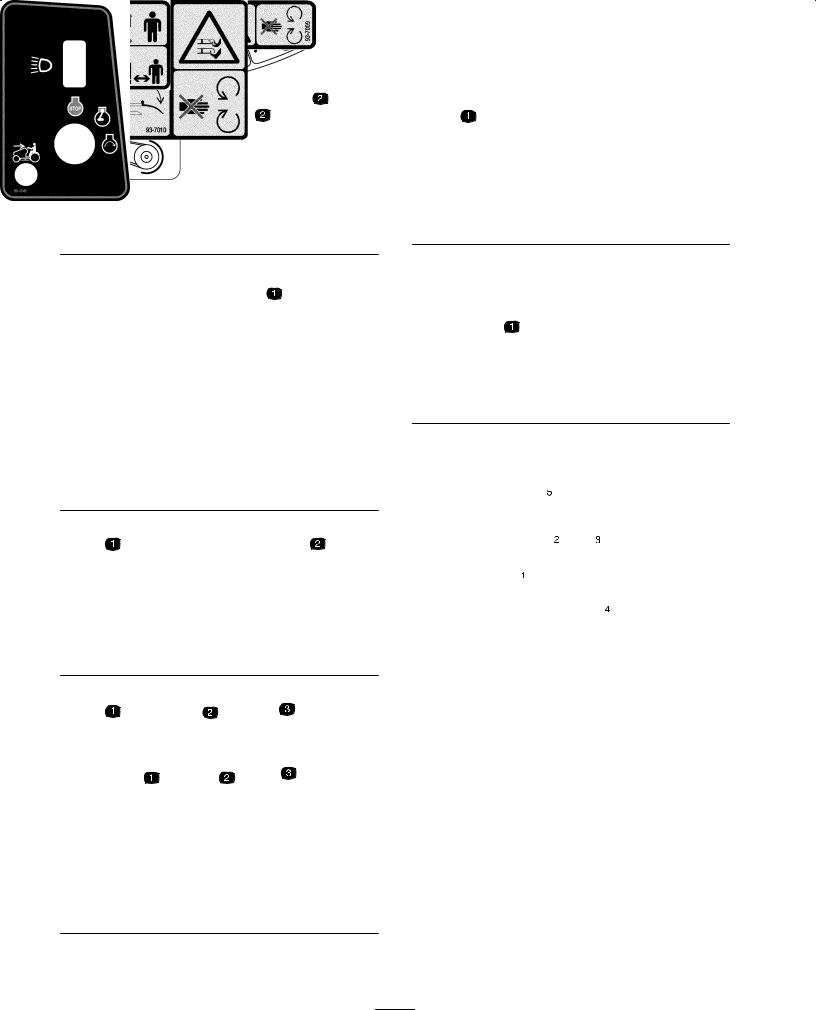
93-6677
1.WarningÐdo not operate the mower with the deflector up or removed; keep the deflector in place.
2.Cutting/dismemberment hazard of hand or foot, mower bladeÐstay away from moving parts.
93-6679
1. Engine
93-7009
1.WarningÐdo not operate the mower with the deflector up or removed; keep the deflector in place.
2.Cutting/dismemberment hazard of hand or foot, mower bladeÐstay away from moving parts.
93-7010
1.Thrown object hazardÐstay a safe distance from the machine.
2.Thrown object hazard, mowerÐkeep the deflector in place.
3.Cutting/dismemberment of hand or footÐstay away from moving parts.
99-2986
1.Crushing/dismemberment hazard of bystandersÐdo not turn the key while children are present; keep children a safe distance from the machine.
99-5340
1. KeyChoiceÐturn to enable reverse mowing.
|
|
99-8141 |
|
|
1. |
Mowing in reverse |
3. |
EngineÐrun |
|
|
enabled |
4. |
EngineÐstart |
|
2. |
EngineÐstop |
|||
5. |
Headlights |
|||
|
|
|||
|
|
|
|
10

100-7449
1. |
Pull the lever out to push |
3. |
Read the instructions |
|
the machine. |
|
before servicing or |
2. |
Push the lever in to ride |
|
performing maintenance. |
|
|
||
|
on the machine. |
4. |
Do not tow the machine. |
|
|
|
|
104-4163
1. |
Explosion hazard |
4. |
Wear eye protection |
2. |
No fire, open flames, or |
5. |
Read the Operator's |
|
smoking. |
|
Manual. |
3. |
Caustic liquid/chemical |
6. |
Keep bystanders a safe |
|
burn hazard |
|
distance from the battery. |
|
|
|
|
1.Contains lead; do not discard.
2.Recycle
3.Wear eye protection; explosive gases can cause blindness and other injuries
104-4164
4. |
No sparks, flame, or |
6. |
Flush eyes immediately with |
|
smoking |
|
water and get medical help |
5. |
Sulfuric acid can cause |
|
fast. |
|
|
||
|
blindness or severe burns. |
7. |
Maximum fill line |
8.Minimum fill line
9.Instructions for activating the battery
11

Gasoline and Oil
Recommended Gasoline
Use unleaded regular gasoline suitable for automotive use (85 pump octane minimum). You may use leaded regular gasoline if unleaded regular is not available.
Important Never use methanol, gasoline containing methanol, or gasohol containing more than 10% ethanol because the fuel system could be damaged. Do not mix oil with gasoline.
Danger
In certain conditions, gasoline is extremely flammable and highly explosive. A fire or explosion from gasoline can burn you and others and can damage property.
•Fill the fuel tank outdoors in an open area when the engine is cold. Wipe up any gasoline that spills.
•Do not fill the fuel tank completely full. Add gasoline to the fuel tank until the level is 1/4 to 1/2 in. (6 to 13 mm) below the bottom of the filler neck. This empty space in the tank allows the gasoline to expand.
•Never smoke when handling gasoline, and stay away from an open flame or where a spark may ignite the gasoline fumes.
•Store gasoline in an approved container and keep it out of the reach of children.
•Never buy more than a 30-day supply of gasoline.
•Always place gasoline containers on the ground away from your vehicle before filling.
•Do not fill gasoline containers inside a vehicle or on a truck or trailer bed because interior carpets or plastic truck bed liners may insulate the container and slow the loss of any static charge.
•When practical, remove gas-powered equipment from the truck or trailer and refuel the equipment with its wheels on the ground.
•If this is not possible, refuel such equipment on a truck or trailer from a portable container, not from a gasoline dispenser nozzle.
•If you must use a gasoline dispenser, keep the nozzle in contact with the rim of the fuel tank or container opening at all times until fueling is complete.
Using Stabilizer/Conditioner
Use a fuel stabilizer/conditioner in the tractor to provide the following benefits:
•It keeps gasoline fresh during storage for up to 90 days. For longer storage, drain the fuel tank.
•It cleans the engine while it runs.
•It eliminates gum-like varnish buildup in the fuel system, which causes hard starting.
Important Do not use fuel additives containing methanol or ethanol.
Add the correct amount of fuel stabilizer/conditioner to the gasoline.
Note: A fuel stabilizer/conditioner is most effective when it is mixed with fresh gasoline. To minimize the chance of varnish deposits in the fuel system, use a fuel stabilizer/conditioner at all times.
Filling the Fuel Tank
1.Stop the engine and wait for all moving parts to stop.
2.Set the parking brake.
3.Clean around the fuel tank cap and remove the cap.
4.Add unleaded regular gasoline to the fuel tank until the level is 1/4 to 1/2 in. (6 to 13 mm) below the bottom of the filler neck. Do not fill the fuel tank completely full.
Note: This space in the tank allows gasoline to expand.
5.Install the fuel tank cap securely.
6.Wipe up any gasoline that spills.
Checking the Engine Oil Level
Before you start the engine and use the tractor, check the oil level in the engine crankcase; refer to Checking the Oil Level on page 21.
12
